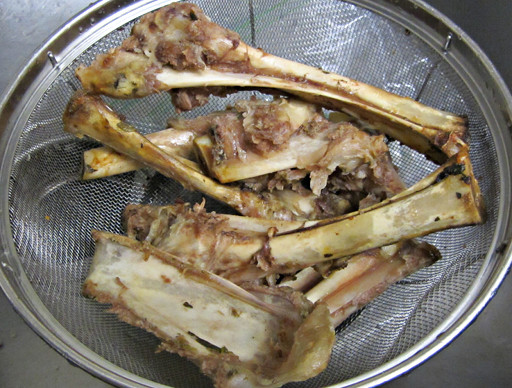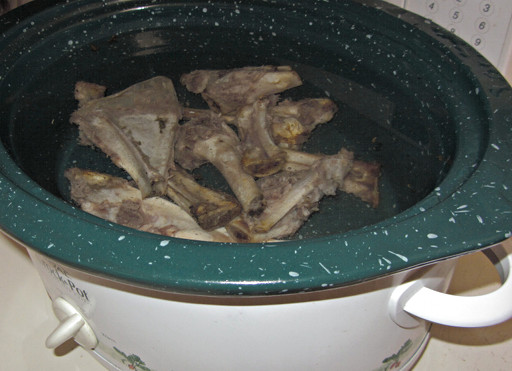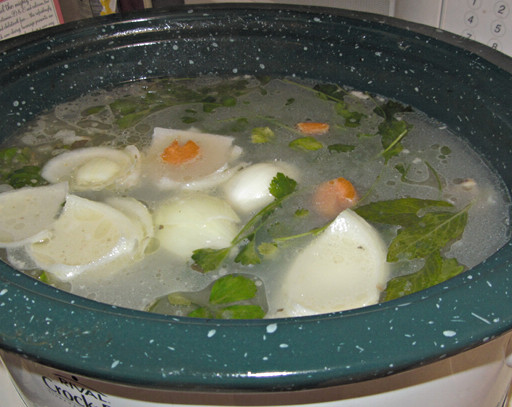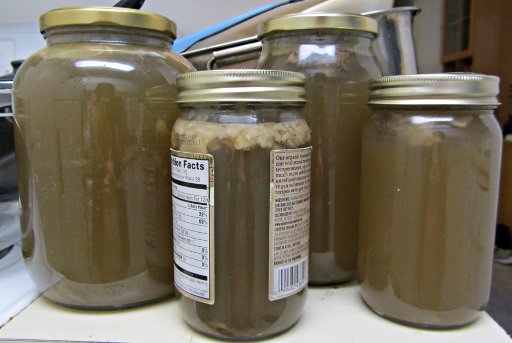One of the superfoods of the Paleo/Primal diets is the bone broth. Drinking it as-is, or cooking stews with it will provide the individual with a lot of minerals and other nutritional advantages: from calcium, to phosphorus, and collagen and Magnesium. Mark Sisson has a great article about the how and whys of bone marrow broths.
However, I have a little known secret about how to get a good bone broth, at a fraction of the price of grass-fed beef bones. See, the few times I bought grass-fed beef bones (and they were not even marrow bones), cost me $22 here in the Bay Area. I’m sorry, but that’s an excessive price for a bunch of bones. Unfortunately, since bones (and liver) are the mirror of how the animal lived its life, I’m not willing to buy non-grass-fed beef bones, and I’m definitely not going to use chicken bones. The quality of the animal must be top-notch to make a bone broth (or eat its offal).
Speaking of chickens, it defeats the whole purpose of the bone broth if it is made from chickens that are younger than 2 years old. We have a saying in Greece: “it’s the older hen that has the extra juice”. Young chickens, especially those that have never walked in their lives, are near-useless when it comes to extracting nutrients out of them. They are sick, and undeveloped. Free-range, older chickens, ducks and turkeys are the better choice.
So if most chickens are unsuitable, and good beef bones are too expensive, what to do? My suggestion is that you go for lamb and goat bones! They are just as nutritious as beef (if not more, especially goats), and the great thing about them is that 90% of them in the US are pastured-raised! Exactly because most Americans don’t eat much sheep/goat, the meat industry hasn’t put its claws around these animals yet to industrialize them. So when you buy meat from these animals, you have a huge chance of actually buying healthy meat!

The best place to buy such meats (including their equally nutritious offal) is Mediterranean shops, but some Mexican markets also carry them. Avoid Chinese markets, unfortunately they carry the cheapest, dead-looking meat I have ever seen (in my big, local Asian market, the only good quality meat I found was duck gizzards and fresh fish).
From lamb, go for lamb shanks ($3.99/lb in my local shop, dirt cheap). From goat, go for a whole leg (not boneless, includes cartilage for extra collagen/gelatin, $6.99/lb). You can also get lamb/goat stew meat if their bones are intact ($6.99/lb). The cheapest deal is of course the lamb shanks. Just make sure you ask the butcher to cut the shanks in two (on the short side), so the marrow is exposed (otherwise, use a sledgehammer at home just before preparing for the bone broth). Basically, you get the bones for cheap, and essentially you get the meat that comes with them “for free” (since a bone broth is the main purpose of the purchase). Financially and nutritionally, they’re the best deal overall!
After you cook and eat the meat, or you remove the bones before cooking, you can freeze the remaining bones, until you have enough to make a bone broth.

Ingredients
* 1 to 1.5 lbs (450-700 gr) of lamb/goat bones
* The juice of a small lemon OR a teaspoon of apple cider vinegar
* 1/2 of a large onion, wedged (avoid if on Fodmaps diet)
* 1/2 cups of celery
* 1-2 chopped carrots
Method
1. Fill your slow cooker with water. Put the bones in. Juice the lemon (helps with extraction of the nutrients). Cover and let simmer for at least 12 hours.
2. 3-5 hours before turning off the heat, add the onion, celery, carrots.

3. If your bones had been cooked before (e.g. in a stew, or roasted), let the bone broth simmer for 20-24 hours, otherwise, 15-16 hours is enough.
4. When done, turn off the heat, uncover, and let cool. When cool, pass the broth through a strainer and discard the bones/veggies. Do not discard the fat. If you have been cooking marrow bones, eat the marrow!
5. Fill up 1-2 big glass jars with the clear broth and store it in your refrigerator for up to 1 week. From that glass jar, you can either cook with (e.g. in stews), or you can pour a cup, add a bit of lemon, microwave it, and drink it as-is.
6. For the rest of the bone broth, using a large ladle, pour 1-1.5 cups of the broth into plastic bags. Seal them well, and place them carefully in your freezer, for up to 3 months. When you want to use some for cooking, you can easily remove the plastic bag by tearing it, while the broth is still frozen.












